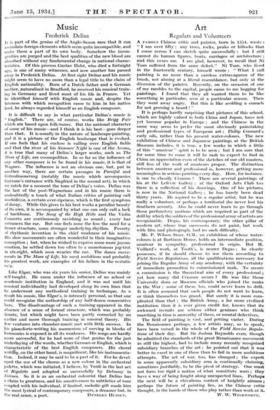Art
Regulars and Volunteers
A FAMOUS Chinese critic and painter, born in 1554, wrote : " I am over fifty ; any trees, rocks, peaks or hillocks that I come across I can sketch quite successfully ; but I still cannot do human figures, boats, carriages or architecture ; and this vexes me. I am glad, however, to recall that Ni Tsan suffered from the same defect." Ni Tsan, who lived
in the fourteenth century, himself wrote : What I call painting is no more than a careless extravaganza of the brush, not aiming at a literal resemblance, but only at the diversion of the painter. Recently, on the occasion of one of my rambles to the capital, people came to me begging for paintings. I found that they all wanted them to be like something in particular, seen at a particular season. Then they went away angry. But this is like scolding a eunuch for not growing a beard ! "
It is perhaps hardly surprising that pictures of this school, which are highly valued in both China and Japan, have not yet become popular in Europe : and the Chinese in the same way seem to prefer the most obviously painstaking and professional types of European art : Philip Connard's early oils, rather than his present water-colours. The new exhibition of Chinese and Japanese paintings at the British Museum includes, it is true, a few works in which a little of this " amateur " spirit is to be seen ; but I am sure that for some time to come it will he rash to expect to find in China an appreciation even of the sketches of our old masters, still less of the work of amateurs proper. The distinction between amateur and professional is, however, getting more meaningless in serious painting every day. How, for instance, is one to classify Cezanne ? There are several paintings of his at the Lefevre Gallery ; at the Oxford Arts Club too there is a collection of his drawings. One of his pictures is now in the National Gallery ; he has barely been dead thirty years. He aspired to be a regular artist, but he was really a volunteer, or perhaps a territorial (he never lost his Southern accent). Also he could never learn to go through those perfunctory motions which are required as part of the drill by which the soldiers of the professional army of artists are recognizable. Degas, his contemporary, the other pillar of modern art, whose true successors do not paint, but work with film and photograph, had no such difficulty.
Mr. P. Wilson Steer, 0.M., an exhibition of whose water- colours is at Barbizon House, holds an intermediate position,
amateur in sympathy, professional in origin. But M. Vuillard's work, at Tooth's, is nearer Degas ; he clearly possesses, if he should choose to use them according to Field Service Regulations, all the qualifications necessary for joining the Regular Army of any academy, with the certainty of immediate promotion to commissioned rank. To secure a commission is the theoretical aim of every professional ; yet how many did Cezanne secure ? He was like those University dons or Museum officials who joined the ranks in the War ; some of these, too, could never learn to drill. It is often assumed that such people do not want to learn, or think themselves too grand. But surely it is more com- plicated than that ; the British Army, a far more civilized institution than it is ever given credit for, knows that its awkward recruits are seldom either geniuses who think marching in time is unworthy of them, or mental defectives.
The field of painting is vast, and getting vaster. During
the Renaissance perhaps, a few artists may, so to speak, have been versed in the whole of the Field Service Regula- tions of their day. But Sir Joshua Reynolds even, though he- admitted the standards of the great Renaissance movement as still the highest, had to include many recently recognized subsidiary branches of the art ; he pointed out that it was better to excel in one of these than to fail in more ambitious attempts. The art of war, too, has changed ; the expert in some apparently subsidiary arm is continually claiming, sometimes justifiably, to be the pivot of strategy. One must not form too rigid a notion of what constitute wars ; they have a way of being fought along unexpected lines. Perhaps the next will be a chivalrous contest of knightly airmen ; perhaps the future of painting lies, as the Chinese critic thought, in the hands of those who play rather than work at it.
W. W. WINICWORTII.
















































 Previous page
Previous page